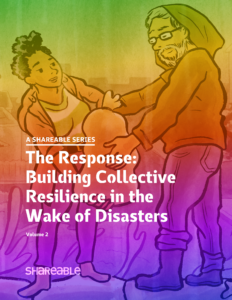While health authorities focus on top-down measures to get COVID-19 supplies to hospitals in need, home-grown initiatives are enlisting regular people to create open-source equipment. Rather than wait for the impact of government efforts to persuade manufacturers to move into emergency production of ventilators and protective equipment, the sharing economy is already saving lives with home-made masks and 3D-printed ventilators.
A dearth of adequate medical supplies was implicated in an increase in coronavirus mortality in Italy, compared with Germany and South Korea, where supply was adequate.
Meeting a desperate need for ventilators through open-sourcing
Health authorities say the immediate short-term need is to get more ventilators, which compress and decompress air for patients who are too weak to breathe on their own.
In Ireland, a community called Open Source Ventilator sprang from a Facebook discussion to develop a simplified, low-cost, emergency ventilator that can be produced at scale from mostly 3D-printed components. Developed in collaboration with frontline healthcare workers, the emergency ventilator can be fabricated from locally sourced supplies and materials so its manufacture is not dependent on a global supply chain.
Before you rush out to hack together your personal ventilator, however, health experts warn that ventilators can do more harm than good if they are not properly constructed and operated. It is necessary to have the correct timing and air pressure, filtration, humidity, and temperature. Improper use can damage lung tissue and may even induce pneumonia. Faulty equipment can aerosolize the virus, causing it to infect others. Johns Hopkins has specifications for open-source ventilators.
Home sewing corps fashion DIY masks
There are open-source projects in numerous cities focusing on producing masks for personal uses and to protect healthcare workers. COVID-19 is one micron wide and most medical masks filter particles down to three microns. So while wearing a mask doesn’t stop all virus particles, it significantly reduces the risk of infection. There is a multitude of how-to videos for how to sew your own mask with the fabric you have but health authorities caution that cotton, as shown in this video, is not good at stopping small particles so air filters should be added to protect down to three microns. The Federal Drug Administration has guidance on producing and wearing DIY and 3D-printed masks during the pandemic.
Home computing power is put to work for drug research
The previous initiatives are aimed at short-term relief but in order to stop the spread of the disease and curb its deadly impact, we need to develop new drugs. The SARS-CoV-2 virus depends on proteins to reproduce, including an important one called the protease. Researchers want to find a molecule that can latch onto this protein and destroy it, paving the way to a therapeutic drug. That research requires a lot of computational power, which is why computer engineers have found a way for average people to donate their computer processors when they’re not using them. The Folding@home project uses software to unite home computers in a network that functions like a distributed supercomputer that can simulate possible drugs to cure the disease. The project is now over twice the size of the world’s largest supercomputer with more than an exaflop of processing power, meaning it can do a quintillion calculations per second. So far, 77 candidate drug compounds have been identified but users have raised concerns about abuse.
There are a number of ways for average people to get involved in fighting this pandemic and it’s clear that it will take all of us to beat the coronavirus. Whether you want to build a ventilator, sew a mask or contribute your excess computing power for research, the sharing economy means we can all play a part.
##
This article is part of our reporting on The People’s COVID-19 Response. Here are a few articles from the series:
- Coronavirus catalyzes growing wave of grassroots action despite social distancing
- The coronavirus pandemic calls us to share more than ever
- The People’s COVID-19 Response needs you
- 10 ways to share during the COVID-19 pandemic
- The pandemic isn’t a portal, yet
- The Response: Resisting COVID-19 with mutual aid in Chico, CA
- 20 ways Shareable readers are helping during the pandemic
 |
Download our free ebook- The Response: Building Collective Resilience in the Wake of Disasters (2019) |









